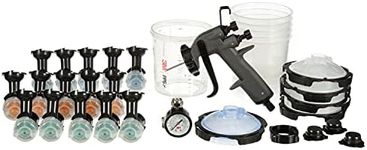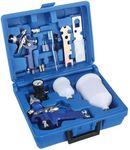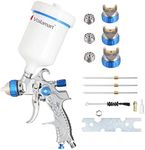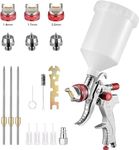Buying Guide for the Best Gravity Paint Spray Gun
Choosing the right gravity paint spray gun can make a significant difference in the quality of your painting projects. Whether you're a professional painter or a DIY enthusiast, understanding the key specifications of a gravity paint spray gun will help you make an informed decision. Here are the essential specs you should consider and how to navigate them to find the best fit for your needs.Nozzle SizeThe nozzle size determines the spray pattern and the type of paint that can be used. Smaller nozzles (1.0-1.3 mm) are ideal for fine finishes and detailed work, such as automotive painting or furniture. Medium nozzles (1.4-1.7 mm) are versatile and can handle a variety of paints and projects, making them suitable for general use. Larger nozzles (1.8 mm and above) are best for thicker materials like primers and heavy coatings. Choose a nozzle size based on the type of projects you plan to undertake and the materials you will be using.
Cup CapacityThe cup capacity refers to the amount of paint the spray gun can hold. Smaller cups (less than 600 ml) are lightweight and easier to handle, making them suitable for small projects or detailed work. Medium cups (600-1000 ml) offer a balance between capacity and maneuverability, ideal for medium-sized projects. Larger cups (over 1000 ml) are best for extensive projects where frequent refilling would be inconvenient. Consider the scale of your projects and how often you want to refill the cup when choosing the right capacity.
Air Pressure RequirementsAir pressure requirements indicate the amount of pressure needed to operate the spray gun effectively. Lower pressure (10-20 PSI) is suitable for fine finishes and detailed work, providing better control and less overspray. Medium pressure (20-30 PSI) is versatile and can handle a variety of tasks, making it a good all-around choice. Higher pressure (30 PSI and above) is necessary for thicker materials and larger projects. Match the air pressure requirements with your air compressor's capabilities and the type of work you plan to do.
Material CompatibilityMaterial compatibility refers to the types of paints and coatings the spray gun can handle. Some spray guns are designed for specific materials like lacquers, enamels, or latex paints, while others are more versatile. Ensure the spray gun you choose is compatible with the materials you plan to use. This will ensure optimal performance and prevent clogging or damage to the gun.
Weight and ErgonomicsThe weight and ergonomics of a spray gun affect how comfortable it is to use, especially for extended periods. Lighter spray guns are easier to handle and reduce fatigue, making them suitable for detailed or prolonged work. Ergonomic designs with comfortable grips and balanced weight distribution enhance control and reduce strain. Consider how long you will be using the spray gun and choose one that feels comfortable and manageable for your needs.
AdjustabilityAdjustability refers to the ability to fine-tune the spray pattern, fluid flow, and air pressure. This feature allows you to customize the spray gun's performance to suit different projects and materials. Look for spray guns with easy-to-use adjustment knobs or dials that provide precise control. If you work on a variety of projects, having a highly adjustable spray gun will give you the flexibility to achieve the best results for each task.














